Biosynthesis of Amino Acids in Xanthomonas oryzae pv. oryzae Is Essential to Its Pathogenicity
Abstract
1. Introduction
2. Materials and Methods
2.1. Bacterial Culture and Growth Conditions
2.2. Xoo Mutation and Complementation
2.3. Virulence Assays
2.4. Raw Amino Acid Extraction from Rice Leaves and Bacterial Growth Assays
2.5. RNA Sequencing (RNA-Seq) and Real-Time Quantitative RT-PCR
2.6. GUS Activity Assays
2.7. Growth Assays
3. Results
3.1. Identification of Essential Genes for Amino Acid Synthesis in Xoo
3.2. Relationship between Amino Acids Synthesis and the Pathogenicity of Xoo
3.3. Free Amino Acids in Rice Leaves Tightly Influence Xoo Growth
3.4. Xoo Has Different Abilities to Utilize Various Amino Acids
3.5. Leucine Regulates Virulence-Related Pathways
4. Discussion
4.1. Relationship between Amino Acid Synthesis and Xoo Virulence
4.2. Pathways for BCAA Synthesis in Xoo
4.3. Possible Mechanism of Leucine Regulation of Xoo Pathogenicity
5. Conclusions
Supplementary Materials
Author Contributions
Funding
Conflicts of Interest
References
- Rai, V.K. Role of Amino Acids in Plant Responses to Stresses. Biol. Plant. 2002, 45, 481–487. [Google Scholar] [CrossRef]
- Grenville-Briggs, L.J.; Avrova, A.O.; Bruce, C.R.; Williams, A.; Whisson, S.C.; Birch, P.R.; van West, P. Elevated amino acid biosynthesis in Phytophthora infestans during appressorium formation and potato infection. Fungal Genet. Biol. 2005, 42, 244–256. [Google Scholar] [CrossRef] [PubMed]
- Takken, F.L.; Tameling, W.I. To nibble at plant resistance proteins. Science 2009, 324, 744–746. [Google Scholar] [CrossRef] [PubMed]
- Kadotani, N.; Akagi, A.; Takatsuji, H.; Miwa, T.; Igarashi, D. Exogenous proteinogenic amino acids induce systemic resistance in rice. BMC Plant Biol. 2016, 16, 60. [Google Scholar] [CrossRef] [PubMed]
- Berney, M.; Berney-Meyer, L.; Wong, K.W.; Chen, B.; Chen, M.; Kim, J.; Wang, J.; Harris, D.; Parkhill, J.; Chan, J.; et al. Essential roles of methionine and S-adenosylmethionine in the autarkic lifestyle of Mycobacterium tuberculosis. Proc. Natl. Acad. Sci. USA 2015, 112, 10008–10013. [Google Scholar] [CrossRef]
- Tiwari, S.; van Tonder, A.J.; Vilcheze, C.; Mendes, V.; Thomas, S.E.; Malek, A.; Chen, B.; Chen, M.; Kim, J.; Blundell, T.L.; et al. Arginine-deprivation-induced oxidative damage sterilizes Mycobacterium tuberculosis. Proc. Natl. Acad. Sci. USA 2018, 115, 9779–9784. [Google Scholar] [CrossRef] [PubMed]
- Mizrahi, V.; Warner, D.F. Death of Mycobacterium tuberculosis by l-arginine starvation. Proc. Natl. Acad. Sci. USA 2018, 115, 9658–9660. [Google Scholar] [CrossRef]
- Liebmann, B.; Muhleisen, T.W.; Muller, M.; Hecht, M.; Weidner, G.; Braun, A.; Brock, M.; Brakhage, A.A. Deletion of the Aspergillus fumigatus lysine biosynthesis gene lysF encoding homoaconitase leads to attenuated virulence in a low-dose mouse infection model of invasive aspergillosis. Arch. Microbiol. 2004, 181, 378–383. [Google Scholar] [CrossRef]
- Do, E.; Hu, G.; Caza, M.; Oliveira, D.; Kronstad, J.W.; Jung, W.H. Leu1 plays a role in iron metabolism and is required for virulence in Cryptococcus neoformans. Fungal Genet. Biol. 2015, 75, 11–19. [Google Scholar] [CrossRef]
- Ren, Z.G.; Jiang, W.J.; Ni, X.Y.; Lin, M.; Zhang, W.; Tian, G.Z.; Zhang, L.Q. Multiplication of Acidovorax citrulli in planta during infection of melon seedlings requires the ability to synthesize leucine. Plant Pathol. 2014, 63, 784–791. [Google Scholar] [CrossRef]
- Su, P.; Song, Z.; Wu, G.; Zhao, Y.; Zhang, Y.; Wang, B.; Qian, G.; Fu, Z.Q.; Liu, F. Insights into the Roles of Two Genes of the Histidine Biosynthesis Operon in Pathogenicity of Xanthomonas oryzae pv. oryzicola. Phytopathology 2018, 108, 542–551. [Google Scholar] [CrossRef] [PubMed]
- Li, C.; Tao, J.; Mao, D.; He, C. A novel manganese efflux system, YebN, is required for virulence by Xanthomonas oryzae pv. oryzae. PLoS ONE 2011, 6, e21983. [Google Scholar] [CrossRef] [PubMed]
- Li, C.; Liu, S.; Liu, P.; Wang, Y.; Xu, C.; Tao, J.; He, C. The YebN Leader RNA Acts as a Mn2+ Sensor Required for the Interaction of Xanthomonas oryzae and Rice. Mol. Plant Microbe Interact. 2018, 31, 932–939. [Google Scholar] [CrossRef] [PubMed]
- Schafer, A.; Tauch, A.; Jager, W.; Kalinowski, J.; Thierbach, G.; Puhler, A. Small mobilizable multi-purpose cloning vectors derived from the Escherichia coli plasmids pK18 and pK19: Selection of defined deletions in the chromosome of Corynebacterium glutamicum. Gene 1994, 145, 69–73. [Google Scholar] [CrossRef]
- Innes, R.W.; Hirose, M.A.; Kuempel, P.L. Induction of nitrogen-fixing nodules on clover requires only 32 kilobase pairs of DNA from the Rhizobium trifolii symbiosis plasmid. J. Bacteriol. 1988, 170, 3793–3802. [Google Scholar] [CrossRef]
- Kaspar, H.; Dettmer, K.; Chan, Q.; Daniels, S.; Nimkar, S.; Daviglus, M.L.; Stamler, J.; Elliott, P.; Oefner, P.J. Urinary amino acid analysis: A comparison of iTRAQ-LC-MS/MS, GC-MS, and amino acid analyzer. J. Chromatogr. B Analyt. Technol. Biomed. Life Sci. 2009, 877, 1838–1846. [Google Scholar] [CrossRef]
- Jefferson, R.A.; Kavanagh, T.A.; Bevan, M.W. GUS fusions: beta-glucuronidase as a sensitive and versatile gene fusion marker in higher plants. EMBO J. 1987, 6, 3901–3907. [Google Scholar] [CrossRef]
- Blomstrand, E. A role for branched-chain amino acids in reducing central fatigue. J. Nutr. 2006, 136, 544S–547S. [Google Scholar] [CrossRef]
- Petroff, O.A. GABA and glutamate in the human brain. Neuroscientist 2002, 8, 562–573. [Google Scholar] [CrossRef]
- Baek, C.H.; Kang, H.Y.; Roland, K.L.; Curtiss, R., 3rd. Lrp acts as both a positive and negative regulator for type 1 fimbriae production in Salmonella enterica serovar Typhimurium. PLoS ONE 2011, 6, e26896. [Google Scholar] [CrossRef]
- Baek, C.H.; Wang, S.; Roland, K.L.; Curtiss, R., 3rd. Leucine-responsive regulatory protein (Lrp) acts as a virulence repressor in Salmonella enterica serovar Typhimurium. J. Bacteriol. 2009, 191, 1278–1292. [Google Scholar] [CrossRef] [PubMed]
- Landini, P.; Hajec, L.I.; Nguyen, L.H.; Burgess, R.R.; Volkert, M.R. The leucine-responsive regulatory protein (Lrp) acts as a specific repressor for sigma s-dependent transcription of the Escherichia coli aidB gene. Mol. Microbiol. 1996, 20, 947–955. [Google Scholar] [CrossRef] [PubMed]
- Liu, F.; Qimuge Hao, J.; Yan, H.; Bach, T.; Fan, L.; Morigen. AspC-mediated aspartate metabolism coordinates the Escherichia coli cell cycle. PLoS ONE 2014, 9, e92229. [Google Scholar] [CrossRef] [PubMed]
- Norton, L.E.; Layman, D.K. Leucine regulates translation initiation of protein synthesis in skeletal muscle after exercise. J. Nutr. 2006, 136, 533S–537S. [Google Scholar] [CrossRef] [PubMed]
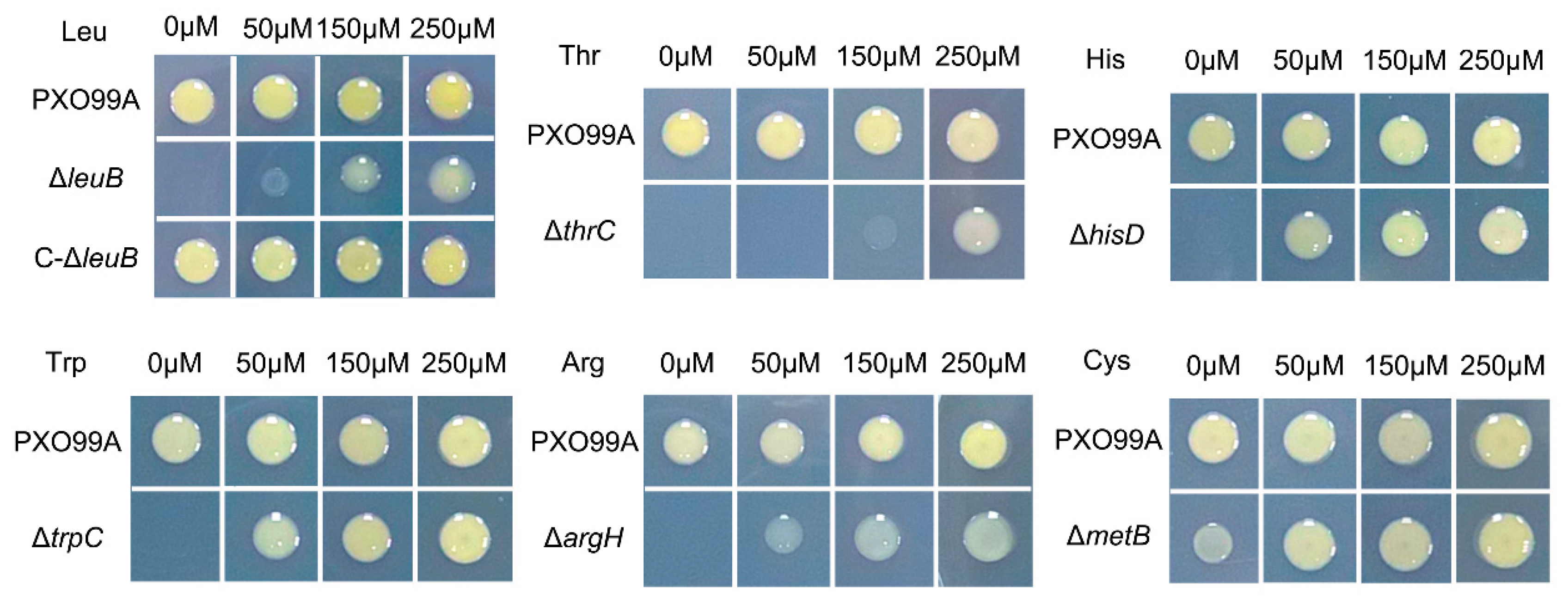
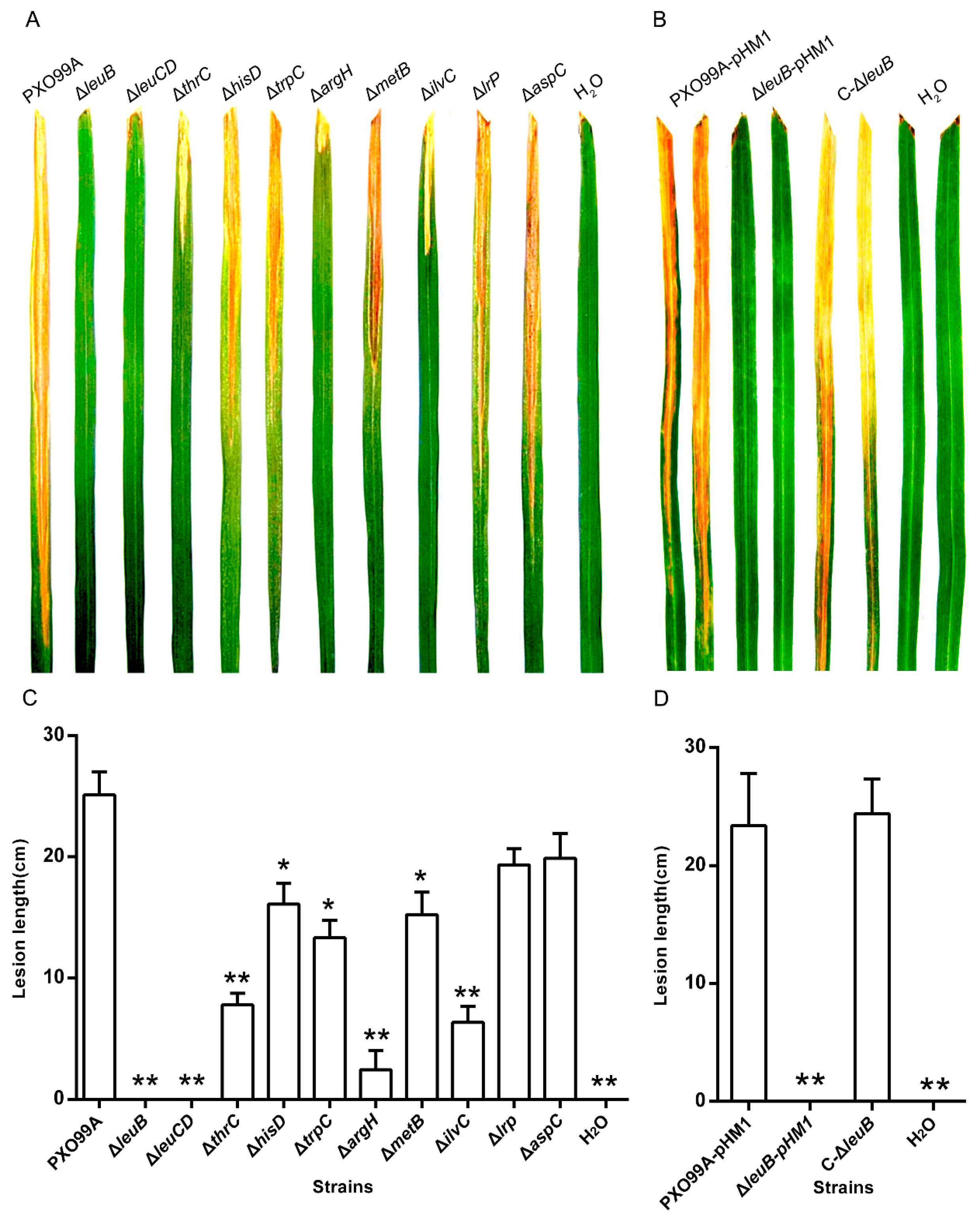
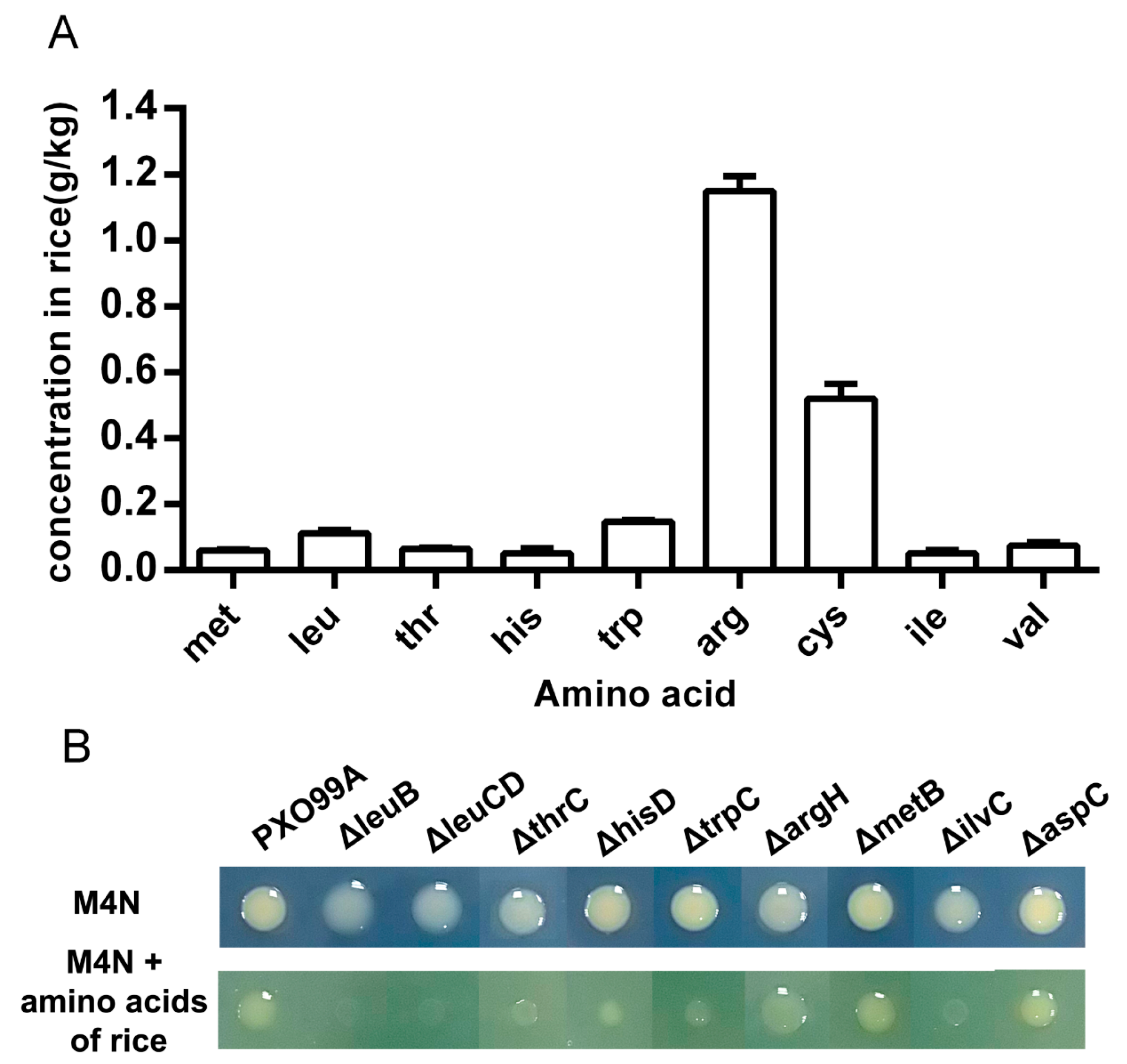

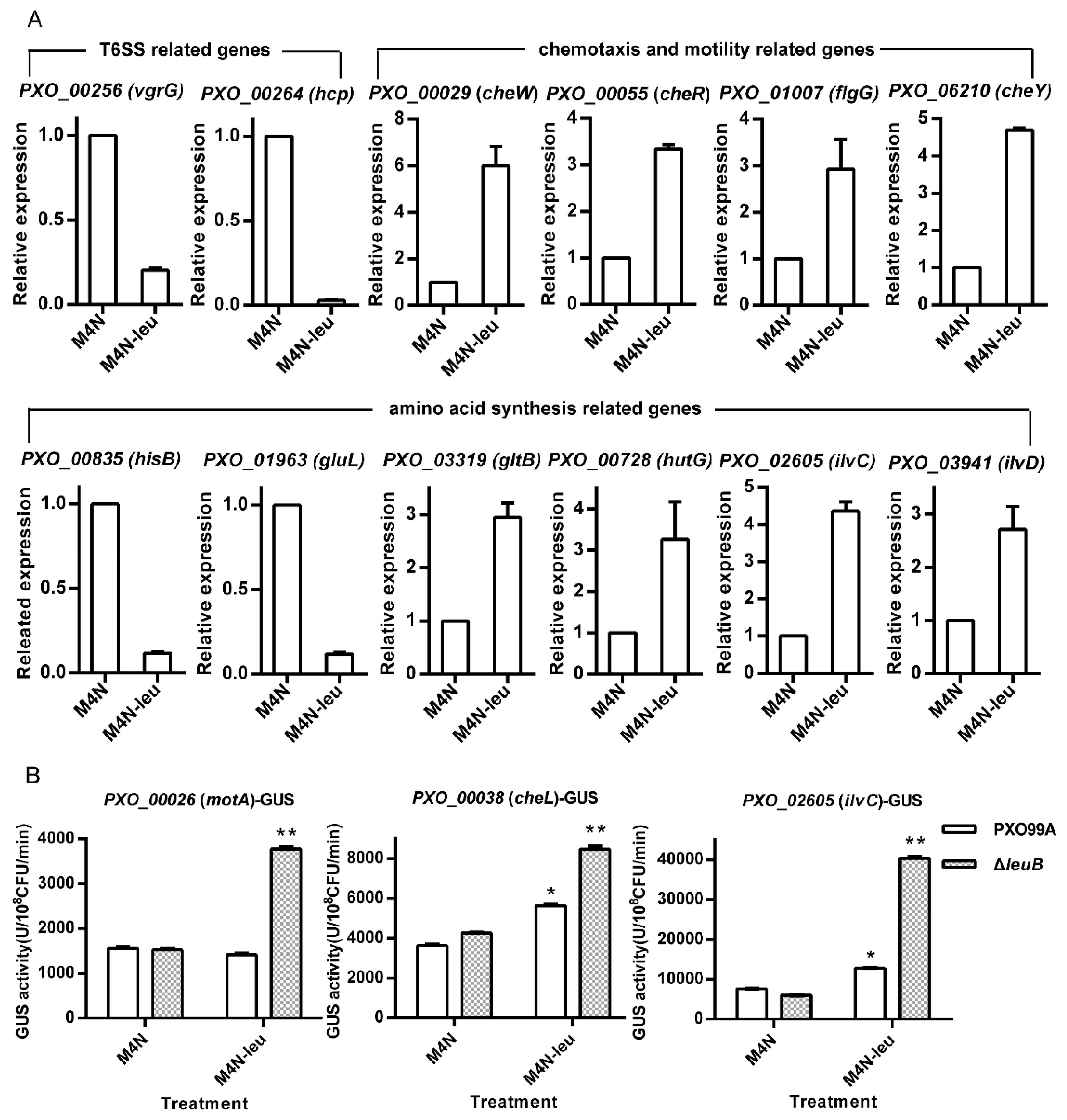
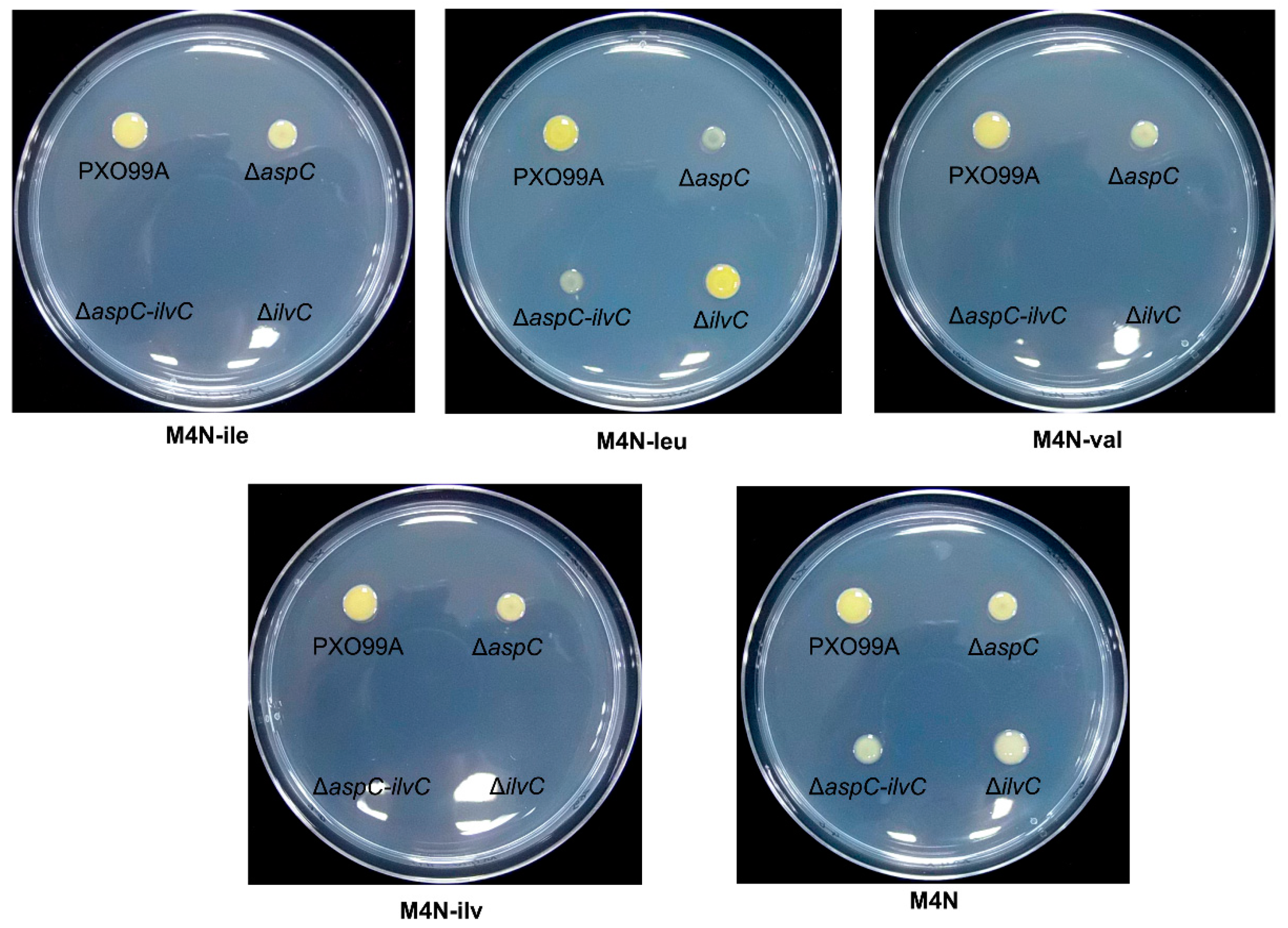
| Entry | Gene Name | Definition | Related Amino Acids |
|---|---|---|---|
| PXO_02610 | leuB | 3-isopropylmalate dehydrogenase | Leu |
| PXO_02612 | leuD | 3-isopropylmalate dehydratase, small subunit | Leu |
| PXO_02613 | leuC | 3-isopropylmalate dehydratase, large subunit | Leu |
| PXO_00822 | thrC | threonine synthase | Thr |
| PXO_00833 | hisD | histidinol dehydrogenase | His |
| PXO_04004 | trpC | indole-3-glycerol phosphate synthase | Trp |
| PXO_00346 | argH | argininosuccinate lyase | Arg |
| PXO_03157 | metB | cystathionine gamma-synthase | Cys |
| PXO_03072 | lrp | leucine responsive regulatory protein | |
| PXO_02605 | ilvC | ketol-acid reductoisomerase | Ile, Val |
| PXO_02420 | aspC | aspartate aminotransferase | Leu, Ala, Arg, et al. |
© 2019 by the authors. Licensee MDPI, Basel, Switzerland. This article is an open access article distributed under the terms and conditions of the Creative Commons Attribution (CC BY) license (http://creativecommons.org/licenses/by/4.0/).
Share and Cite
Li, T.; Zhan, Z.; Lin, Y.; Lin, M.; Xie, Q.; Chen, Y.; He, C.; Tao, J.; Li, C. Biosynthesis of Amino Acids in Xanthomonas oryzae pv. oryzae Is Essential to Its Pathogenicity. Microorganisms 2019, 7, 693. https://doi.org/10.3390/microorganisms7120693
Li T, Zhan Z, Lin Y, Lin M, Xie Q, Chen Y, He C, Tao J, Li C. Biosynthesis of Amino Acids in Xanthomonas oryzae pv. oryzae Is Essential to Its Pathogenicity. Microorganisms. 2019; 7(12):693. https://doi.org/10.3390/microorganisms7120693
Chicago/Turabian StyleLi, Ting, Zhaohong Zhan, Yunuan Lin, Maojuan Lin, Qingbiao Xie, Yinhua Chen, Chaozu He, Jun Tao, and Chunxia Li. 2019. "Biosynthesis of Amino Acids in Xanthomonas oryzae pv. oryzae Is Essential to Its Pathogenicity" Microorganisms 7, no. 12: 693. https://doi.org/10.3390/microorganisms7120693
APA StyleLi, T., Zhan, Z., Lin, Y., Lin, M., Xie, Q., Chen, Y., He, C., Tao, J., & Li, C. (2019). Biosynthesis of Amino Acids in Xanthomonas oryzae pv. oryzae Is Essential to Its Pathogenicity. Microorganisms, 7(12), 693. https://doi.org/10.3390/microorganisms7120693





